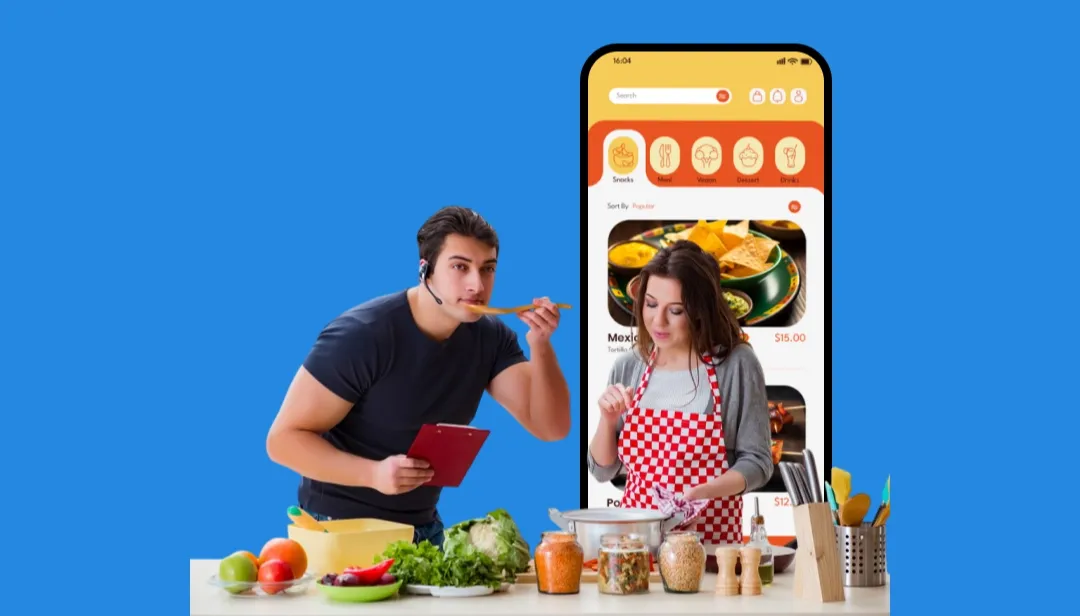How To Start A Food Business? Profitable Food Business Ideas

Neeraj Rajput
Apr 25, 2025

The online food business market is increasing rapidly and it's not slowing down anytime soon. With changing customer habits, growing demand for doorstep food delivery, and the rise of health-conscious eating, the digital food industry provides a golden opportunity for entrepreneurs, startups or enterprises. Whether it’s launching a cloud kitchen, meal prep service, or a snack delivery brand, starting an online food business in 2025 can be both smart and highly profitable.
In this blog, we’ll walk you through how to start an online food business from scratch and explore some of the most profitable online food business ideas backed by current market trends. If you’re looking to invest into this growing digital space, now is the perfect time to turn your cooking and food passion into a scalable business.
Market Stats for Online Food Delivery Industry
The global food industry is one of the fastest-growing sectors and with its digital presence, reshaping how consumers search, order, and enjoy food, the online food business has become a great opportunity.
-
Revenue in the Food market amounts to US$9.43tn in 2025. The market is expected to grow annually by 6.41% CAGR from 2025 to 2030.
-
The market's largest segment is the segment Meat with a market volume of US$1.55tn in 2025.
-
In global comparison, most revenue generated in China is US$2tn in 2025.
-
In relation to total population figures, per person revenues of US$1.20k are generated in 2025.
-
In the online food delivery industry, 8.6% of total revenue will be generated through online sales by 2025.
-
In the Food market, volume is expected to amount to 3.12tn kg by 2030. The Food market is expected to show a volume growth of 3.9% in 2026.
-
The average volume per person in the Food market is expected to amount to 343.29kg in 2025.
10+ Online Food Business Ideas for Startups
Starting an online food delivery business is not just trendy, it's a smart decision for startups. With minimal operating charges, large audience reach, and increasing consumer demand, online food delivery startups are thriving in today’s market. Whether you're a foodie, a chef, or an entrepreneur looking for a scalable food business idea, here are 10+ profitable online food business ideas that you can start from home or a small kitchen setup:
1. Cloud Kitchen
A Cloud Kitchen, also known as a Ghost Kitchen or Virtual Kitchen and a great food business idea with low operational cost. It is a delivery only restaurant that doesn’t offer dine-in services. It operates at a commercial kitchen and allows food ordering only via food delivery apps like Zomato and Swiggy. With the rise in demand of online food ordering apps and changing customer behavior, cloud kitchens have become a booming trend in the food and beverage (F&B) industry.
Benefits of Cloud Kitchens
-
Low Maintenance Costs
-
Faster Launch and Scalability.
-
Multiple Brands Under One Roof
-
Data-Driven Decisions
-
Operational Efficiency
Challenges of Cloud Kitchens
-
Heavy Dependence on Delivery Platforms
-
Limited Customer Experience
-
Brand Visibility and Trust
-
High Competition
-
Logistics and Quality Control
2.Tiffin & Meal Services
Tiffin and Meal Subscription Services offer pre-cooked, ready-to-eat meals delivered regularly to customers at their homes or workplaces. This home delivery food business idea works especially for working professionals, students, and families looking for homemade food without the hassle of daily cooking. Typically available on a daily, weekly, or monthly subscription basis, these food businesses combine convenience, affordability, and nutrition, making them an attractive alternative to eating out.
Benefits of Tiffin & Meal Services
-
Convenience and Time-Saving
-
Home-Style, Nutritious Meals
-
Cost-Effective
-
Predictable Demand and Revenue
-
Customization and Flexibility
Challenges of Tiffin & Meal Subscription Services
-
Maintaining Food Quality and Consistency
-
Logistics and Delivery Management
-
High Customer Expectations
-
Operational Challenges
-
Competition and Pricing Pressure
3.Home Bakery or Dessert Delivery Business
Home Bakery or Dessert Delivery is a great food business idea for startups. Businesses that offer freshly baked goods such as cakes, pastries, cookies, and other desserts, delivered directly to customers’ homes or offices. This business typically caters to customers looking for custom cakes for special occasions, everyday treats, or dessert cravings. With a growing demand for personalized and fresh baked food, this profitable food business idea has become a popular food business from home.
Benefits of Home Bakery or Dessert Delivery Services
- Fresh, Homemade Quality
- Personalization and Customization
- Convenience and Accessibility
- Niche and Specialized Offerings
- Stronger Customer Relationships
Challenges of Home Bakery or Dessert Delivery Services
- Maintaining Consistency in Quality
- Delivery Logistics
- Shelf Life and Freshness
- Competition with Larger Chains
- Regulatory and Food Safety Concerns
4. Healthy Snacks & Superfoods Store
A Healthy Snacks & Superfoods Store is an e-commerce online snacks business idea, specializing in nutritious, including minimally processed food items such as protein bars, kale chips, chia seeds, and ancient grains positioned to meet growing consumer demand for health-focused, convenient snacks. By curating a range of nutrient-dense products, this online selling food idea appeals to busy professionals, fitness enthusiasts, and anyone looking to boost their wellbeing without sacrificing taste or convenience.
Benefits of Starting an Online Healthy Snacks & Superfoods Store
-
Rapidly Growing Market
-
High Margins & Repeat Purchases
-
Wide Product Diversity
-
Data-Driven Personalization
-
Community & Brand Building
Challenges of Starting an Online Healthy Snacks & Superfoods Store
-
Sourcing & Supply Chain Complexity
-
Inventory Management & Shelf Life
-
Differentiation & Brand Trust
-
Regulatory Compliance
-
Customer Acquisition Costs
5. Ready-to-Cook Meal Kits
This is one of the food businesses that make money. Ready-to-Cook Meal Kits are curated boxes containing pre-measured ingredients and step-by-step recipe cards, delivered to customers’ home doorsteps. Unlike traditional meal subscriptions, these kits require minimal prep, typically chopping, seasoning, and cooking—allowing home cooks to enjoy a chef-quality experience without the hassle of meal planning or grocery shopping.
Benefits of Starting a Ready-to-Cook Meal Kit Business
- Convenience & Time Savings
- Higher Perceived Value
- Menu Flexibility & Seasonal Offerings
- Educational & Experiential Appeal
- Predictable Revenue & Inventory Planning
Challenges of Starting a Ready-to-Cook Meal Kit Business
- Complex Logistics & Cold-Chain Management
- High Fulfillment Costs
- Recipe Development & Standardization
- Churn & Subscription Fatigue
- Regulatory & Food Safety Compliance
6. Homemade Pickles, Sauces & Chutneys
This is a great small food business idea from home. Homemade Pickles, Sauces & Chutneys are crafted from fresh fruits, vegetables, herbs, and spices. Unlike mass-produced jarred goods, these food business ideas offerings emphasize small-batch quality, unique flavor profiles, and traditional or innovative preservation techniques.
Benefits of Starting a Homemade Pickles, Sauces & Chutneys Business
- High Perceived Craftsmanship
- Longer Shelf Life & Low Waste
- Broad Market Appeal
- Add-On & Gift Bundle Opportunities
- Storytelling & Brand Loyalty
Challenges of Starting a Homemade Pickles, Sauces & Chutneys Business
- Regulatory Compliance & Labeling
- Scaling Production Without Quality Loss
- Packaging & Shipping Delicacies
- Ingredient Sourcing & Seasonality
- Customer Education & Market Awareness
7. Food Blog + Recipe E-commerce
A Food Blog + Recipe E-commerce venture combines a content-driven food blog—featuring recipes, cooking tips, and culinary stories with an integrated online store selling digital and physical products, a new food business idea. Offerings can include downloadable recipe e-books, meal plans, cooking classes, branded kitchen tools, specialty ingredients, and subscription boxes. This hybrid food business model leverages engaging content to build an audience, then monetizes that traffic through direct sales, affiliate partnerships, and premium memberships.
Benefits of Starting a Food Blog + Recipe E-commerce Business
- Multiple Revenue Streams
- SEO & Organic Traffic
- Community & Brand Loyalty
- Low Barrier to Entry & Scalable
- Data-Driven Product Development
Challenges of Starting a Food Blog + Recipe E-commerce Business
- High Competition & Content Saturation
- Converting Readers into Buyers
- Technical & Fulfillment Complexity
- Content Consistency & Burnout
- Legal & Compliance Considerations
8. Frozen or Pre-Packaged Food Delivery
Frozen or Pre-Packaged Food Delivery businesses idea offer ready-made meals or ingredients that customers can store in their freezers and heat or assemble at home. These services cater to time-pressed individuals and families who want the convenience of prepared foods without sacrificing variety or quality. Offerings range from single-serve entrées and family-sized meals to meal components delivered at home, a new food business idea.
Benefits of Starting a Frozen or Pre-Packaged Food Delivery Business
- Extended Shelf Life & Reduced Waste
- Scalable Production & Predictable Fulfillment
- Convenience for Customers
- Diverse Menu Possibilities
- Lower Delivery Logistics Complexity
Challenges of Starting a Frozen or Pre-Packaged Food Delivery Business
- Packaging & Shipping Costs
- Freezer Space & Storage Requirements
- Maintaining Taste & Texture
- Regulatory and Food Safety Compliance
- Customer Education & Expectations
9. Pet Food Business
A Pet Food Business, a high profit food business specializes in producing and selling nutrition products for animals dogs, cats, birds, reptiles, and small mammals. Offerings can range from premium dry kibbles and wet foods to specialized treats, raw diets, and subscription-based meal plans. With pet ownership on the rise and owners treating pets as family members, the market for high-quality, health-focused pet nutrition is booming, starting an online food delivery business with this cloud to be profitable.
Benefits of Starting an Online Pet Food Business
- Steady, Recurring Revenue
- Premium Pricing Power
- Broad Product Line Extensions
- Data-Driven Personalization
- Community & Brand Loyalty
Challenges of Starting an Online Pet Food Business
- Regulatory Compliance & Safety Standards
- Sourcing High-Quality Ingredients
- Inventory & Shelf-Life Management
- Shipping Costs & Logistics
- Customer Education & Trust-Building
10. Virtual Cooking Classes or Workshops
Virtual Cooking Classes or Workshops are live or pre-recorded online sessions where professional chefs, culinary enthusiasts, or nutrition experts teach participants how to prepare specific dishes, master cooking techniques, or explore cuisine styles and a great online food business idea from home. Delivered via video conferencing platforms or on-demand portals, these classes cater to home cooks seeking interactive, educational experiences without leaving their kitchens.
Benefits of Starting Virtual Cooking Classes or Workshops
- Low Overhead & Flexible Scheduling
- Global Reach & Scalable Audience
- Diverse Revenue Streams
- Deepened Engagement & Community Building
- Data-Driven Content Development
Challenges of Starting Virtual Cooking Classes or Workshops
- Technical Setup & Streaming Quality
- Curriculum Design & Pacing
- Customer Acquisition & Retention
- Interactivity & Feedback Loop
- Pricing & Perceived Value
How to Start a Food Business: Step-by-Step Guide
Starting a food business is a dream for many—but with the right planning, strategy, and execution, it can also be a highly rewarding and profitable venture. But the question arises is “How to Start a food business from home”. Whether you're planning to launch a small home kitchen, a cloud kitchen, or a full-scale restaurant, this step-by-step guide on starting a small food business idea, will help you launch your food business from concept to execution.
1: Define Your Food Business Idea
Begin by identifying your niche. Ask yourself:
-
What kind of food do you want to offer?
-
Will you go for dine-in, takeaway, or online delivery?
-
Who is your target audience?
Popular food business models include:
-
Cloud kitchens (online delivery only)
-
Tiffin/meal prep services
-
Home bakery or catering
-
Café or QSR (Quick Service Restaurant)
-
Packaged food/snacks business
2: Research the Market
Understanding your market is critical while starting a food business. Conduct research on:
-
Current food trends in your area
-
Competitor analysis
-
Customer preferences
-
Pricing strategy
Use this data to define your unique selling proposition (USP) and position your brand effectively.
3: Create a Business Plan
A solid business plan acts as your roadmap. Include:
-
Business overview
-
Menu or product list
-
Target audience
-
Budget and startup costs
-
Marketing plan
-
Revenue goals and growth strategy
This plan is also essential if you’re looking to attract investors or get a business loan.
4: Choose the Right Setup
Depending on your budget and food business model, decide whether to:
-
Start from home (ideal for tiffin or home bakery businesses)
-
Rent a commercial kitchen (for cloud kitchens or large-scale cooking)
-
Open a physical location (café, restaurant, or takeaway joint)
Each online food delivery business model has different legal and infrastructure requirements.
5: Take Care of Legal Requirements
Ensure your food business idea complies with local laws and health regulations. This may include:
-
Business registration (LLP, proprietorship, or company)
-
Food safety license (e.g., FSSAI in India)
-
GST registration
-
Health and trade permits
-
Fire and safety compliance (for dine-in outlets)
Check your local government website for specific requirements.
6: Build Your Menu and Pricing Strategy
Create a simple and focused menu that reflects your brand and appeals to your target market. Ensure:
-
Ingredient availability
-
Balanced cost-to-profit ratio
Flexible pricing based on portion size and demand
Test a few dishes with family, friends, or a small focus group before finalizing the menu.
7: Source Equipment and Ingredients
Procure quality kitchen equipment and raw materials. Establish relationships with:
-
Local suppliers or wholesalers
-
Packaging vendors
-
Delivery partners (for online orders)
White starting a food business, Invest in essentials like storage containers, cooking tools, POS systems, and hygiene supplies.
8: Build Your Online Presence
Today, a digital presence is crucial even for small food businesses ideas. Set up:
-
A professional, mobile-friendly website
-
Google Business Profile for local visibility
-
Active social media accounts (Instagram, Facebook, etc.)
-
Listings on food delivery apps (Zomato, Swiggy, Uber Eats, etc.)
Consider using food photography, reviews, and influencer marketing to attract customers online.
9: Promote Your Launch
Create buzz around your food business with:
-
Launch-day discounts or giveaways
-
Social media campaigns
-
Collaboration with food bloggers
-
Referral and loyalty programs
A good launch can give you a strong first impression and help you build a loyal customer base.
10: Monitor, Improve, and Scale
Once your online food delivery business is live:
-
Track sales and customer feedback
-
Optimize your menu and pricing
-
Invest in marketing and branding
-
Explore partnerships or expansion
Use digital tools like Google Analytics, delivery platform dashboards, and customer surveys to refine your strategy.
Why Developing a Food Delivery App or Website is Crucial for Your Food Business?
As everything available online, having a strong online presence for your business isn’t just an advantage for now it’s a necessity. With the growing demand of easy convenience, speed delivery and contactless food delivery experiences, customers expect to browse menus, place orders, and make payments directly through their smartphones or computers. This makes food delivery app development absolutely crucial for any online food business aiming to scale and compete.
Here’s why:
1. Direct Customer Access & Better Control
Having your food delivery app or website means you don’t have to rely entirely on third-party platforms like Zomato or Uber Eats. You can:
-
Control your branding, pricing, and promotions
-
Collect valuable customer data
-
Build stronger customer relationships through loyalty programs and personalized offers
2. Increased Brand Credibility
A professional, user-friendly food ordering app or website adds instant credibility to your brand. It shows that your business is modern, reliable, and ready to meet the demands of today’s tech-savvy customers.
3. Lower Commission Fees
Third-party food delivery platforms often charge 20–30% commission per order, eating into your profits. Your own delivery app or web platform helps reduce dependency on aggregators and retain more revenue.
4. Better Customer Experience
A dedicated food delivery app or website allows you to offer a seamless and customized user experience, including:
-
Real-time order tracking
-
Easy reordering
-
Secure online payments
-
Reviews and ratings
-
Push notifications for deals and updates
5. Scalable and Future-Ready
As your food ordering business grows, so will your customer base. A mobile app or website is highly scalable, making it easier to:
-
Launch multiple outlets
-
Handle large order volumes
-
Integrate CRM and analytics tools
-
Run marketing campaigns more effectively
6. Data-Driven Decisions
With access to real-time order data and customer behavior insights, you can make smarter decisions related to:
-
Popular menu items
-
Peak order times
-
Targeted promotions
-
Inventory and delivery planning
7. 24/7 Sales Channel
Unlike physical outlets, your food delivery app or website operates round the clock. This lets customers place orders anytime—helping you capture sales even after business hours or during holidays.
Build Your Food Delivery App with IMG Global Infotech!
At IMG Global Infotech, we combine deep industry knowledge with cutting-edge technology to deliver powerful, user-friendly and food delivery apps tailored to your business needs. With over a decade of experience in mobile and web development, we specialize in creating custom food tech solutions that are scalable, secure, and designed to drive results. Our team understands the fast-paced nature of the food industry and builds apps that offer real-time order tracking, seamless payment integration, intuitive UI/UX, and complete admin control. Whether you're a startup or an established brand, we provide end-to-end restaurant app development, support, and strategic guidance to help you launch and grow your food delivery business with confidence.































